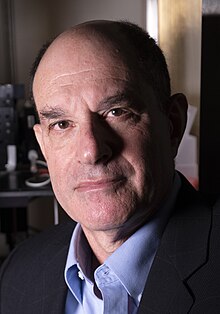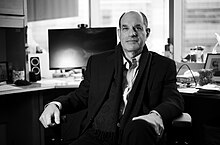David Julius
David Julius | |
|---|---|
 Julius in 2022 | |
| Born | November 4, 1955 New York City, U.S. |
| Education | Massachusetts Institute of Technology (BS) University of California, Berkeley (MS, PhD) Columbia University (post-doctoral training) |
| Spouse | Holly Ingraham |
| Awards |
|
| Scientific career | |
| Fields | Physiology Biochemistry Neuroscience |
| Institutions | University of California, San Francisco |
| Thesis | Protein processing and secretion in yeast: biosynthesis of α-factor mating pheromone (1984) |
| Doctoral advisor | Jeremy Thorner Randy Schekman |
| Other academic advisors | Richard Axel[1] Alexander Rich |
David Jay Julius (born November 4, 1955) is an American physiologist and Nobel Prize laureate known for his work on molecular mechanisms of pain sensation and heat, including the characterization of the TRPV1 and TRPM8 receptors that detect capsaicin, menthol, and temperature. He is a professor at the University of California, San Francisco.
Julius won the 2010 Shaw Prize in Life Science and Medicine and the 2020 Breakthrough Prize in Life Sciences.[2][3] He was awarded the 2021 Nobel Prize in Physiology or Medicine jointly with Ardem Patapoutian.[4]
Early life and education
Julius was born to an Ashkenazi Jewish family (from Russia) in Brighton Beach, Brooklyn, New York City,[5] where he attended Abraham Lincoln High School.[6] He earned his undergraduate degree from Massachusetts Institute of Technology in 1977. He attained his doctorate from University of California, Berkeley in 1984, under joint supervision of Jeremy Thorner and Randy Schekman, where he identified Kex2 as the founding member of furin-like proprotein convertases.[7] In 1989, he completed his post-doctoral training with Richard Axel at Columbia University where he cloned and characterized the serotonin 1c receptor.[8]
While at Berkeley and Columbia, Julius became interested in how psilocybin mushrooms and lysergic acid diethylamide work, which led him to look more broadly into how things from nature interact with human receptors.[6]
Research career

He started his career as faculty at the University of California, San Francisco in 1989.[9][10] In 1997, Julius's lab cloned and characterized TRPV1 which is the receptor that detects capsaicin, the chemical in chili peppers that makes them "hot".[11] They found that TRPV1 also detects noxious heat (thermoception).[11][12] TRPV1 is part of a large family of structurally related TRP (transient receptor potential) cation channels. Animals that lack TRPV1 (using genetic knockouts of the protein) lose sensitivity to noxious heat and capsaicin.[13]
Julius's lab has also cloned and characterized TRPM8 (CMR1) and TRPA1, both members of the TRP superfamily. They demonstrated that TRPM8 detects menthol and cooler temperatures[14][15] and TRPA1 detects mustard oil (allyl isothiocyanate).[16] These observations suggested that TRP channels detect a range of temperatures and chemicals. David Julius's lab has also made contributions to the study of nociception by discovering toxins that modulate these channels,[17] describing unique adaptations of the channels in diverse species[18] and solving the cryo-EM structures of numerous channels.[19][20]

From 2007–2020 Julius served as the editor of the peer-reviewed journal the Annual Review of Physiology.[21][22]
Awards
In 2000, Julius was awarded the inaugural Perl-UNC Neuroscience Prize for his work on cloning the capsaicin receptor. In 2010, he won the Shaw Prize for his work identifying the ion channels involved in various aspects of nociception. In 2014, he was honored by Johnson & Johnson with the Dr. Paul Janssen Award for Biomedical Research for discovering the molecular basis for pain and thermosensation. In 2017, he won the Gairdner Foundation International Award[23] and the HFSP Nakasone Award.[24] He has also been awarded the 2010 Prince of Asturias Prize for Technical and Scientific Research, the 2020 Breakthrough Prize in Life Sciences,[25] and the 2020 Kavli Prize in Neuroscience (together with Ardem Patapoutian)[26] and the 2020 BBVA Foundation Frontiers of Knowledge Award.[27]
In 2021, he was awarded the Nobel Prize in Physiology or Medicine jointly with Ardem Patapoutian for their discoveries of receptors for temperature and touch.[28]
See also
References
- ^ "Julius Lab at UCSF Mission Bay | David Julius Lab". Archived from the original on May 23, 2013. Retrieved November 30, 2013.
- ^ "Julius Named to Receive the Shaw Prize". ucsf.edu. Archived from the original on April 29, 2019. Retrieved December 5, 2016.
- ^ "David Julius, PhD 49th Faculty Research Lecture Award". senate.ucsf.edu. Archived from the original on August 1, 2020. Retrieved December 5, 2016.
- ^ "The Nobel Prize in Physiology or Medicine 2021". NobelPrize.org. Archived from the original on October 4, 2021. Retrieved October 4, 2021.
- ^ Hanau, Shira (October 4, 2021). "Scientist David Julius, whose grandparents fled antisemitism in Czarist Russia, wins Nobel Prize in medicine". Jewish Telegraphic Agency. Retrieved October 4, 2021.
- ^ a b Mueller, Benjamin; Santora, Marc; Engelbrecht, Cora (October 4, 2021). "Nobel Prize Awarded for Research About Temperature and Touch". New York Times. Retrieved October 5, 2021.
- ^ Julius, David Jay (1984). Protein Processing and Secretion in Yeast: Biosynthesis of Alpha-Factor Mating Pheromone (Ph.D. thesis). University of California, Berkeley. OCLC 21756165. ProQuest 303332941.
- ^ Julius, D.; MacDermott, A. B.; Axel, R.; Jessell, T. M. (July 29, 1988). "Molecular characterization of a functional cDNA encoding the serotonin 1c receptor". Science. 241 (4865): 558–564. Bibcode:1988Sci...241..558J. doi:10.1126/science.3399891. ISSN 0036-8075. PMID 3399891.
- ^ "David Julius '77 shares the Nobel Prize in physiology or medicine". MIT News | Massachusetts Institute of Technology. Retrieved October 7, 2021.
- ^ "The Nobel Prize in Physiology or Medicine 2021". NobelPrize.org. Retrieved October 7, 2021.
- ^ a b Caterina, M. J.; Schumacher, M. A.; Tominaga, M.; Rosen, T. A.; Levine, J. D.; Julius, D. (October 23, 1997). "The capsaicin receptor: a heat-activated ion channel in the pain pathway". Nature. 389 (6653): 816–824. Bibcode:1997Natur.389..816C. doi:10.1038/39807. ISSN 0028-0836. PMID 9349813. S2CID 7970319.
- ^ Tominaga, M.; Caterina, M. J.; Malmberg, A. B.; Rosen, T. A.; Gilbert, H.; Skinner, K.; Raumann, B. E.; Basbaum, A. I.; Julius, D. (September 1998). "The cloned capsaicin receptor integrates multiple pain-producing stimuli". Neuron. 21 (3): 531–543. doi:10.1016/S0896-6273(00)80564-4. ISSN 0896-6273. PMID 9768840. S2CID 2054891.
- ^ Caterina, M. J.; Leffler, A.; Malmberg, A. B.; Martin, W. J.; Trafton, J.; Petersen-Zeitz, K. R.; Koltzenburg, M.; Basbaum, A. I.; Julius, D. (April 14, 2000). "Impaired nociception and pain sensation in mice lacking the capsaicin receptor". Science. 288 (5464): 306–313. Bibcode:2000Sci...288..306C. doi:10.1126/science.288.5464.306. ISSN 0036-8075. PMID 10764638.
- ^ McKemy, David D.; Neuhausser, Werner M.; Julius, David (March 7, 2002). "Identification of a cold receptor reveals a general role for TRP channels in thermosensation". Nature. 416 (6876): 52–58. Bibcode:2002Natur.416...52M. doi:10.1038/nature719. ISSN 0028-0836. PMID 11882888. S2CID 4340358.
- ^ Bautista, Diana M.; Siemens, Jan; Glazer, Joshua M.; Tsuruda, Pamela R.; Basbaum, Allan I.; Stucky, Cheryl L.; Jordt, Sven-Eric; Julius, David (July 12, 2007). "The menthol receptor TRPM8 is the principal detector of environmental cold". Nature. 448 (7150): 204–208. Bibcode:2007Natur.448..204B. doi:10.1038/nature05910. ISSN 1476-4687. PMID 17538622. S2CID 4427901.
- ^ Jordt, Sven-Eric; Bautista, Diana M.; Chuang, Huai-Hu; McKemy, David D.; Zygmunt, Peter M.; Högestätt, Edward D.; Meng, Ian D.; Julius, David (January 15, 2004). "Mustard oils and cannabinoids excite sensory nerve fibres through the TRP channel ANKTM1". Nature. 427 (6971): 260–265. Bibcode:2004Natur.427..260J. doi:10.1038/nature02282. ISSN 1476-4687. PMID 14712238. S2CID 4354737.
- ^ Bohlen, Christopher J.; Chesler, Alexander T.; Sharif-Naeini, Reza; Medzihradszky, Katalin F.; Zhou, Sharleen; King, David; Sánchez, Elda E.; Burlingame, Alma L.; Basbaum, Allan I. (November 16, 2011). "A heteromeric Texas coral snake toxin targets acid-sensing ion channels to produce pain". Nature. 479 (7373): 410–414. Bibcode:2011Natur.479..410B. doi:10.1038/nature10607. ISSN 1476-4687. PMC 3226747. PMID 22094702.
- ^ Gracheva, Elena O.; Ingolia, Nicholas T.; Kelly, Yvonne M.; Cordero-Morales, Julio F.; Hollopeter, Gunther; Chesler, Alexander T.; Sánchez, Elda E.; Perez, John C.; Weissman, Jonathan S. (April 15, 2010). "Molecular basis of infrared detection by snakes". Nature. 464 (7291): 1006–1011. Bibcode:2010Natur.464.1006G. doi:10.1038/nature08943. ISSN 1476-4687. PMC 2855400. PMID 20228791.
- ^ Liao, Maofu; Cao, Erhu; Julius, David; Cheng, Yifan (December 5, 2013). "Structure of the TRPV1 ion channel determined by electron cryo-microscopy". Nature. 504 (7478): 107–112. Bibcode:2013Natur.504..107L. doi:10.1038/nature12822. ISSN 1476-4687. PMC 4078027. PMID 24305160.
- ^ Cao, Erhu; Liao, Maofu; Cheng, Yifan; Julius, David (December 5, 2013). "TRPV1 structures in distinct conformations reveal activation mechanisms". Nature. 504 (7478): 113–118. Bibcode:2013Natur.504..113C. doi:10.1038/nature12823. ISSN 1476-4687. PMC 4023639. PMID 24305161.
- ^ Julius, David (2007). "David Julius for the ARP Editorial Committee". Annual Review of Physiology. 69. doi:10.1146/annurev.ph.69.013107.100001.
- ^ "Editor of the Annual Review of Physiology - Volume 82, 2020". Annual Reviews. Retrieved July 26, 2021.
- ^ "David Julius – Gairdner Foundation". Gairdner Foundation. Archived from the original on October 22, 2020. Retrieved November 1, 2018.
- ^ "The 2017 HFSP Nakasone Award goes to David Julius | Human Frontier Science Program". www.hfsp.org. Archived from the original on November 9, 2018. Retrieved November 9, 2018.
- ^ "Breakthrough Prize – Winners Of The 2020 Breakthrough Prize In Life Sciences, Fundamental Physics And Mathematics Announced". breakthroughprize.org. Archived from the original on December 14, 2019. Retrieved October 4, 2021.
- ^ "2020 Kavli Prize in Neuroscience". www.kavliprize.org. Archived from the original on June 15, 2020. Retrieved May 27, 2020.
- ^ "homepage". Premios Fronteras. Archived from the original on September 21, 2021. Retrieved October 4, 2021.
- ^ "The Nobel Prize in Physiology or Medicine 2021". NobelPrize.org. Archived from the original on October 4, 2021. Retrieved October 4, 2021.
External links
- Articles with short description
- Short description matches Wikidata
- Use mdy dates from October 2021
- Articles with hCards
- Commons category link from Wikidata
- Articles with ISNI identifiers
- Articles with VIAF identifiers
- Articles with WorldCat Entities identifiers
- Articles with BNE identifiers
- Articles with GND identifiers
- Articles with LCCN identifiers
- Articles with ORCID identifiers
- Articles with Scopus identifiers
- 1955 births
- Abraham Lincoln High School (Brooklyn) alumni
- American people of Russian-Jewish descent
- American physiologists
- Annual Reviews (publisher) editors
- Jewish American scientists
- Kavli Prize laureates in Neuroscience
- Living people
- Massachusetts Institute of Technology alumni
- Members of the United States National Academy of Sciences
- Nobel laureates in Physiology or Medicine
- Scientists from New York City
- University of California, Berkeley alumni
- Columbia University staff
- University of California, San Francisco faculty
- Members of the National Academy of Medicine